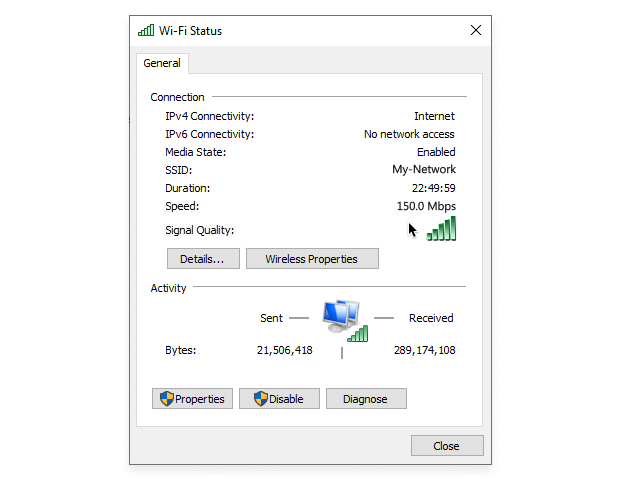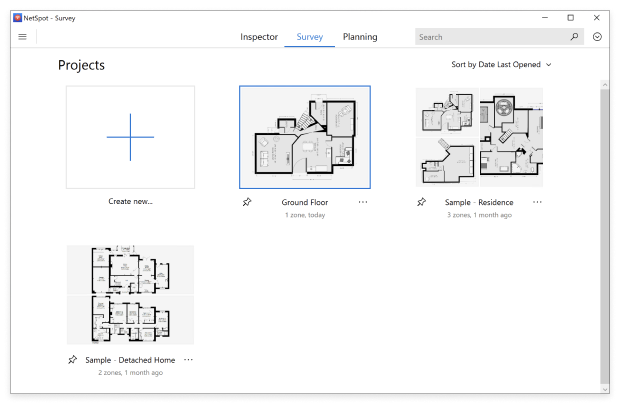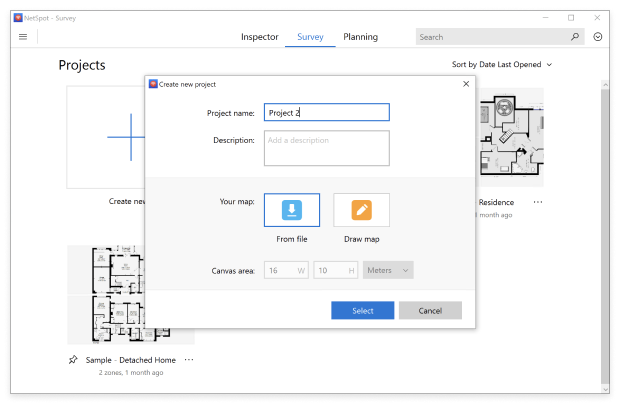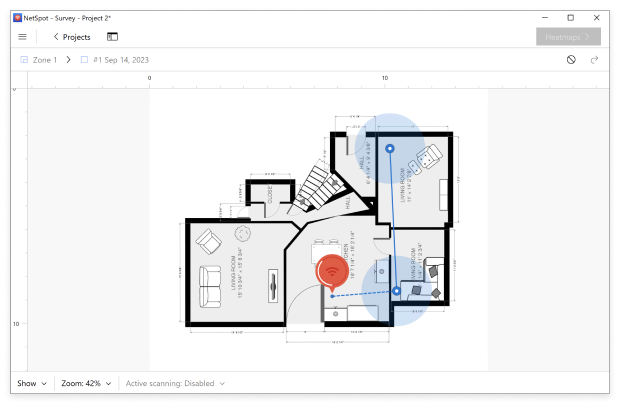Wi-Fi现场勘测,分析,故障排查运行于具有标准802.11a/b/g/n/ac/ax无线网络适配器的MacBook (macOS 11+)或任何笔记本电脑(Windows 7/8/10/11)。
没有什么比使用信号弱的 WiFi 更令人沮丧的事情了。当网站加载速度很慢,在线视频和音频流每隔几秒就会中断时,愤怒和挫败感很快就会出现。
好消息是,测量WiFi信号强度 非常简单,您绝对不需要成为专家或拥有专业设备。您只需要选择本文中描述的方法之一,并按照我们的详细步骤操作即可。
如何使用任务栏图标检查 Wi-Fi 信号强度 (Windows 10 和 11)?
检查 Windows 10 和 Windows 11 上 WiFi 信号强度的最快方式是打开操作中心并查看 WiFi 状态图标。您需要执行以下操作:
在 Windows 10 上
单击位于任务栏右侧的操作中心图标。
点击底部的WiFi图标。
计算条数。
在 Windows 11 上
点击“快速设置”区域(网络、音量和电池的组合图标)然后展开可用的 Wi-Fi 网络。
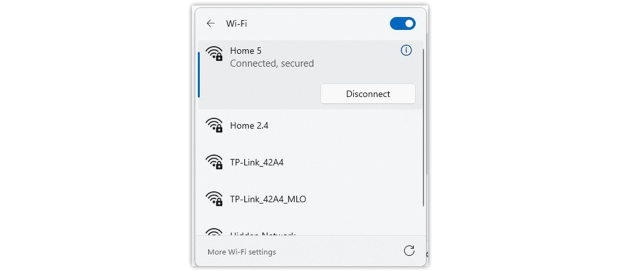
确保您已连接到正确的 Wi-Fi 网络。信号强度通过信号条数来指示:
- 四个信号条:极佳信号。
- 三个信号条:良好信号,通常稳定。
- 两个信号条:一般信号,可能会有速度下降。
- 一个信号条或一个点:信号非常弱,可能会断开连接。
如何使用设置检查 Wi-Fi 信号强度?
Windows 10(以及更新版本如 Windows 11)提供了一个新的设置菜单,您可以在此菜单中控制操作系统的各个方面,并检查您的Wi-Fi 信号强度。以下是操作步骤:
打开“设置”
- Windows 10: 单击开始→设置(齿轮图标)
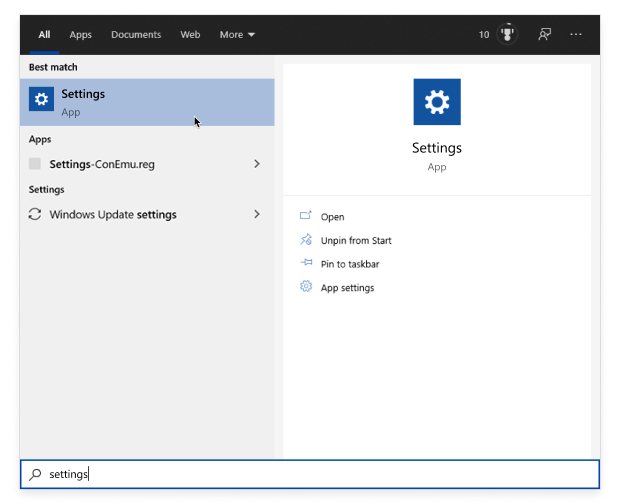
- Windows 11: 点击开始 → 设置(在英文操作系统上)或相应的本地化选项。
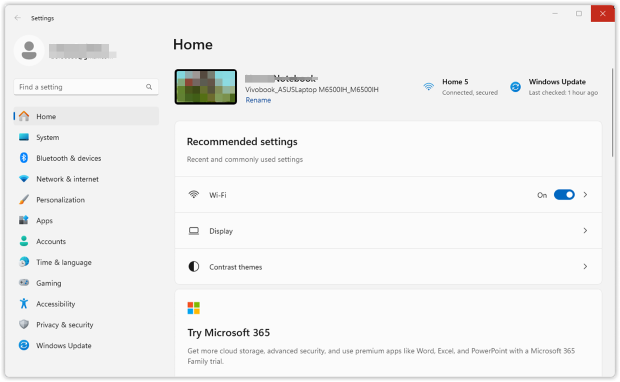
启动设置应用并转到网络和互联网。
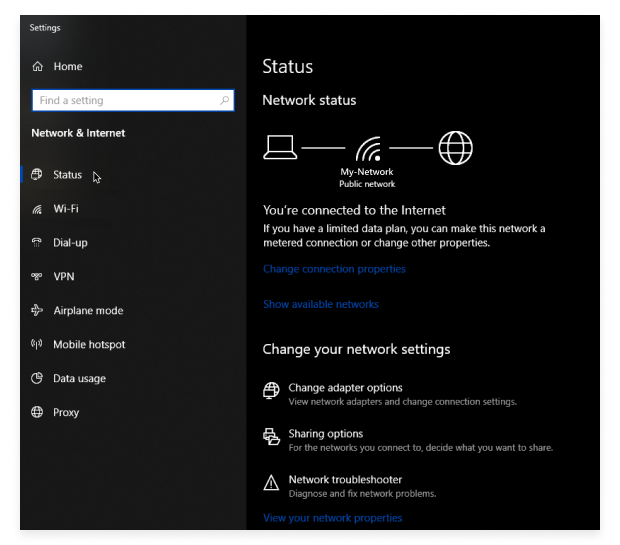
点击“Wi-Fi”
在 Windows 10 中,您将看到左侧菜单。在左侧窗格中选择状态,并数一下信号条数以确定信号的大致强度。
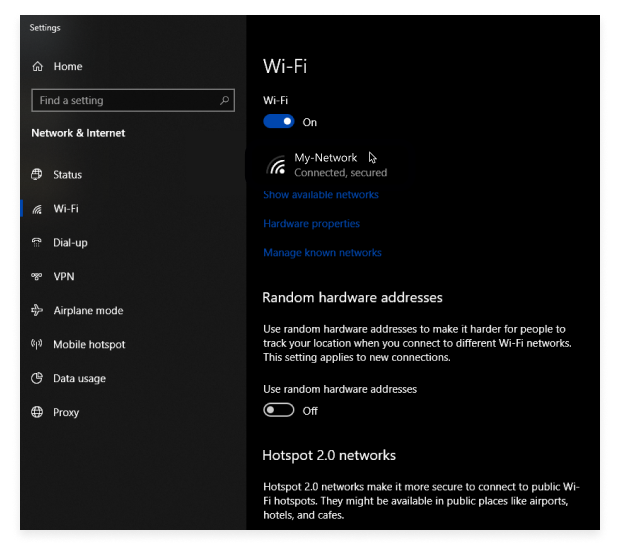
在 Windows 11 中,它的外观可能有些不同,但遵循相同的原则来查找 WiFi 设置。
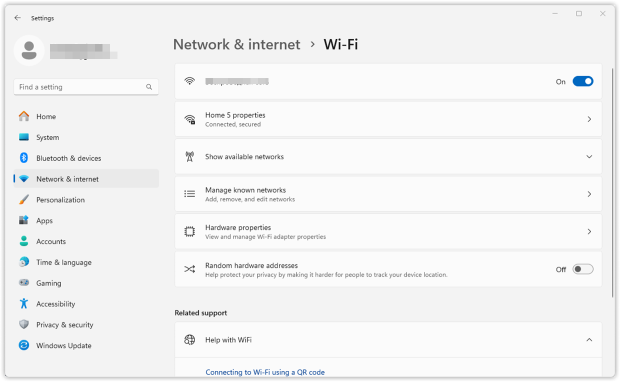
找到您的网络名称。旁边的Wi-Fi图标显示了填充了多少条,表示信号强度。
或者,您也可以进入Wi-Fi部分,在那里您还可以访问您的Wi-Fi适配器的硬件属性和其他有用的设置。
如何使用控制面板检查Wi-Fi信号?
这种方法适用于那些更喜欢使用传统控制面板而不是新的设置应用程序的Windows用户。由于控制面板中的WiFi信号强度计非常基础,所以不要期望看到有关您的WiFi的详细信息。
适用于Windows 10和Windows 11。
尽管Windows 11具有全新的设置界面,但控制面板仍然可用,并且与Windows 10上的工作方式类似。
打开开始菜单并输入“控制面板”
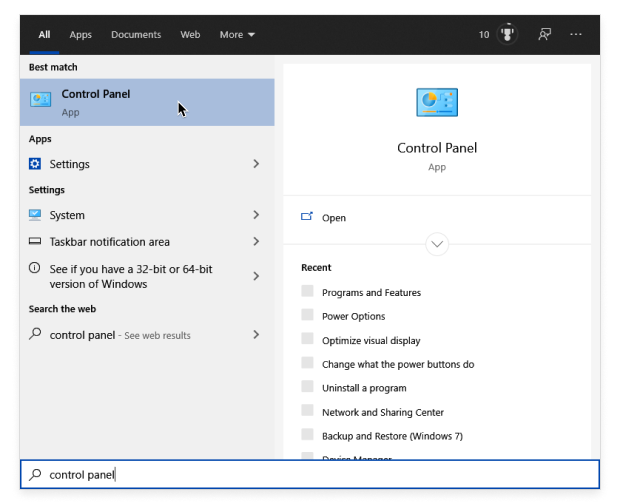
启动控制面板应用程序,进入网络和Internet。
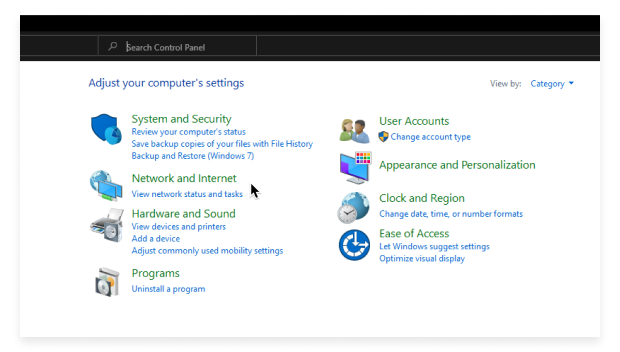
选择查看网络状态和任务。
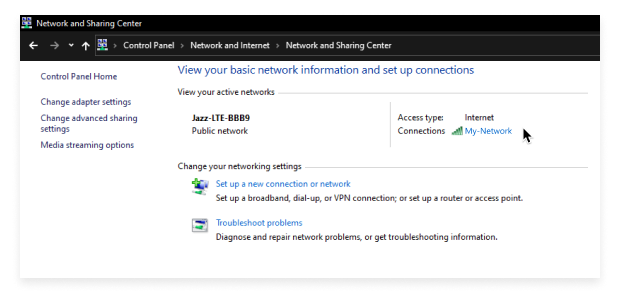
如何使用命令提示符检查Wi-Fi信号?
不可思议的是,您可以使用强大的命令提示符来检查您的WiFi网络状态,该应用程序是Windows 10和Windows 11中可用的命令行解释器。学习如何使用命令提示符检查WiFi信号强度非常简单,因为整个过程只涉及一个命令:
打开开始菜单并输入“命令提示符”
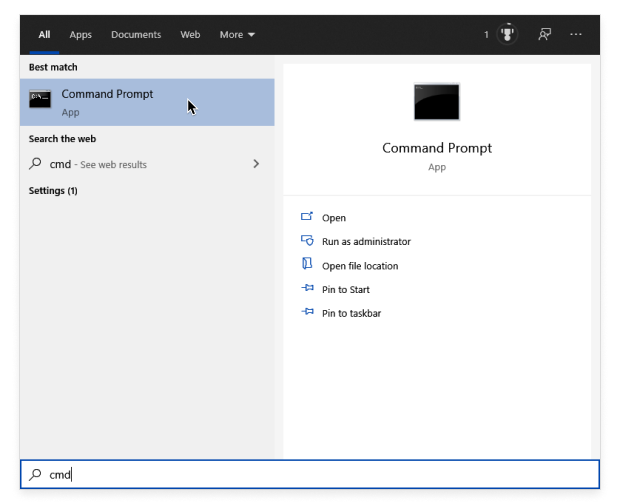
按 Win + R 快捷键,输入 cmd,然后按 Enter。

运行 Netsh 命令。启动命令提示符后,键入以下命令并按回车键:netsh wlan show interfaces。
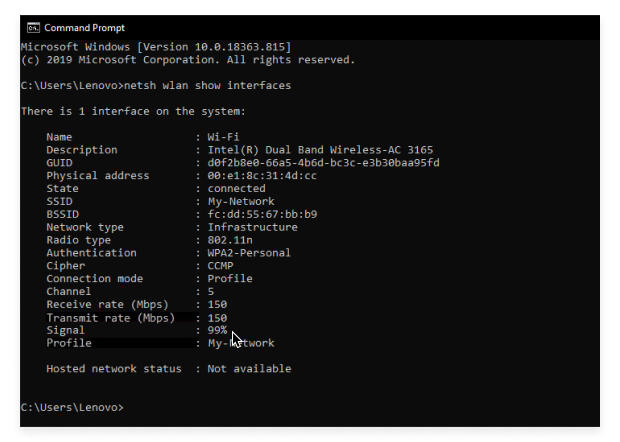
检查“信号”值。寻找标有信号的行。你会看到一个百分比值。
- 75%是相当好的。
- 80–100%的值被认为是极好的。
通过查看信号百分比,你可以快速评估你的Wi-Fi连接强度,并决定是否需要移动路由器、更新驱动程序或采取其他步骤来改善信号。
如何使用PowerShell检查WiFi信号?
你可以将 PowerShell 视为命令提示符的增强版。它由一个命令行外壳和一个强大的脚本语言组成,能够实现复杂的任务自动化和配置管理。但不用担心:使用 PowerShell 检查 WiFi 信号不需要任何脚本。
按 Windows + X 并选择 Windows PowerShell。
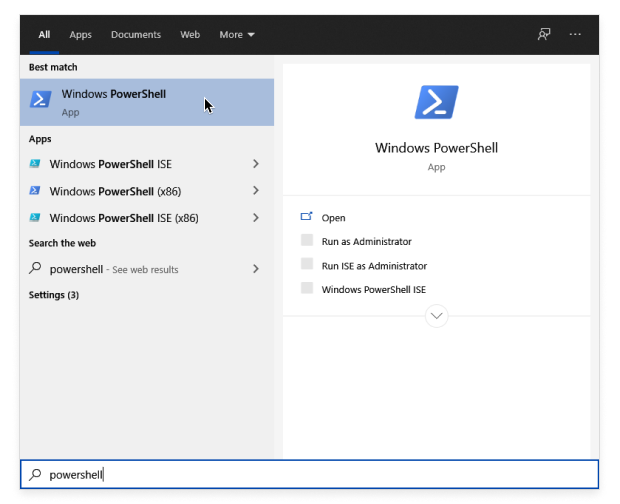
对于Windows 11
使用键盘快捷键 Win + R,输入 powershell,然后按 Enter 以启动 PowerShell 窗口。
(在 Windows 11 上,你也可以打开 Windows Terminal 并选择 PowerShell。
然后,执行以下命令之一:
netsh wlan show interfaces | Select-String ‘^\s+Signal’
或者
(netsh wlan show interfaces) -Match ‘^\s+Signal’ -Replace ‘^\s+Signal\s+:\s+’,”

您的信号强度将显示在底部附近。理想情况下,您希望它在 80 到 100 之间。如果低于这个范围,执行网页浏览或视频聊天等任务的体验会变得不太令人满意。
如何使用 NetSpot 检查 Wi-Fi 信号?
如何检查WiFi信号强度的上述方法仅提供非常基本的信息。如果您只是需要快速确定弱WiFi信号是否是您连接问题的根源,那么这些方法可以满足您的需求,但真正的故障排除需要采用不同的方法:例如NetSpot这样的综合WiFi信号强度应用程序。
除了是我们首选的Windows WiFi信号强度测量器外,NetSpot还是测量Mac上WiFi信号强度的最佳应用程序之一,使得可视化、管理、故障排除、审计、规划和部署无线网络变得非常容易。
使用NetSpot检查WiFi信号的两种方式:您可以使用检测模式收集所有周围WiFi网络的详细信息,或者使用勘测模式在地图上描绘现实中的WiFi数据。
如何使用NetSpot的检查模式检查WiFi信号
启动 NetSpot 并切换到 Inspector 模式。
请稍等片刻,让Wifi信号强度应用程序收集周围WiFi网络的信息。
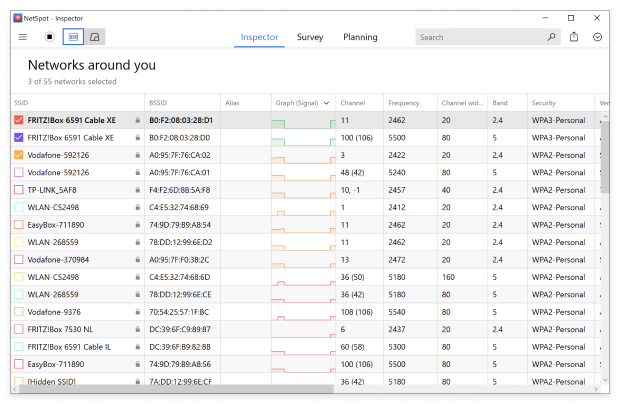
双击您感兴趣的网络以查看有关其信号强度、信道重叠等的实时信息。
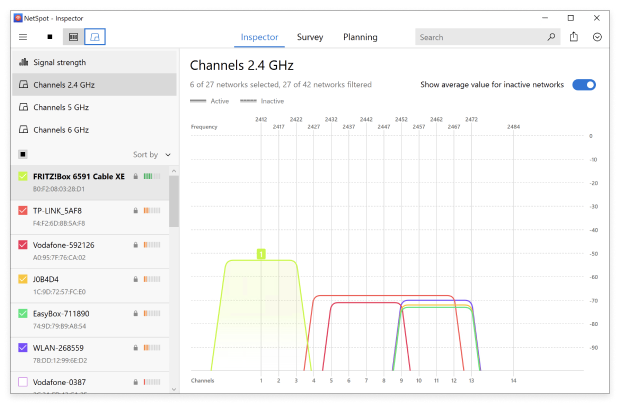
NetSpot 的检查模式非常适合快速、轻松地获取您本地区域内所有无线活动的全面视图,这对于排除 WiFi 信号干扰和其他问题至关重要。
此方法对于需要最大化Wi-Fi覆盖的大型住宅或办公室特别有帮助。
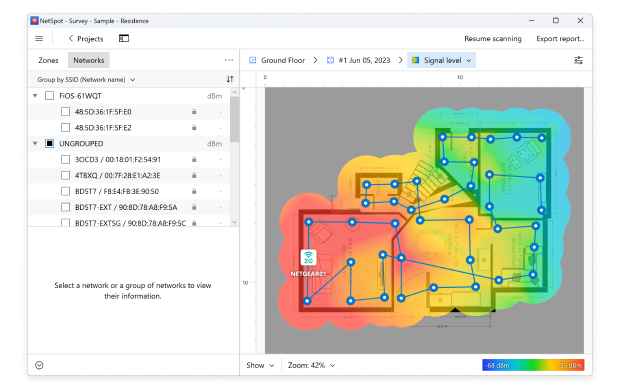
NetSpot 提供超过 20 种热图可视化工具,帮助解决几乎所有与 WiFi 相关的问题。例如,该应用程序可以可视化信噪比、信号强度、噪声级别、频段覆盖、无线传输速率等。
您可以从其官方网站免费下载 NetSpot,在经过足够的时间评估应用程序以确定它可以满足您的需求和要求后,再购买家庭版、专业版或企业版许可证。组织可以购买折扣的公司范围许可证,此外还有一个适用于 Android 的NetSpot 版本,在没有笔记本电脑时非常方便。
信号弱时怎么办?
如果你的信号在50-60%(甚至更低)左右,试试以下步骤:
- 将路由器移近你的主要工作站。墙壁、金属和其他电子设备会削弱信号。
- 更新Wi-Fi适配器和PC上的驱动以及路由器的固件。较新的版本可以解决稳定性问题。
- 如果路由器和设备支持,切换到5 GHz频段;它通常受干扰较少,但范围较短。
- 如果你空间很大或有很多障碍物,使用Wi-Fi扩展器或Mesh系统。
- 检查是否有微波炉、蓝牙设备、无线电话等干扰,尤其是在2.4 GHz频段上。
- 使用NetSpot的调查模式进行全面调查,视觉定位死角并相应地重新放置路由器。
结语
在 Windows 10 和 Windows 11 中测量 Wi-Fi 信号非常简单,无论是使用任务栏、设置等内置工具,还是更高级的方法如 NetSpot。如果信号太弱,请尝试移动路由器、更新驱动程序,或使用中继器或 Mesh 扩展覆盖范围。
请记住:强大的 Wi-Fi 意味着稳定的互联网、更高的速度和更流畅的整体生产力。通过诊断和解决弱点,您可以在家中或办公室享受无缝连接。
常见问题
是的,大多数内置工具(任务栏、设置、控制面板)不需要管理员权限。然而,某些PowerShell或CMD命令可能需要以管理员身份运行,具体取决于您的系统设置。
不同设备使用不同的 Wi-Fi 适配器,可能会以不同的方式显示信号强度。手机可能会显示更多的信号格,因为它们的硬件更优化或灵敏度阈值更低。
单独升级不会增强无线信号的物理范围,但Windows 11可能提供更好的驱动兼容性和性能优化。
过程是一样的。只需确保您的台式机有一个工作正常的 Wi-Fi 适配器(内部或 USB)以便检测无线网络。
